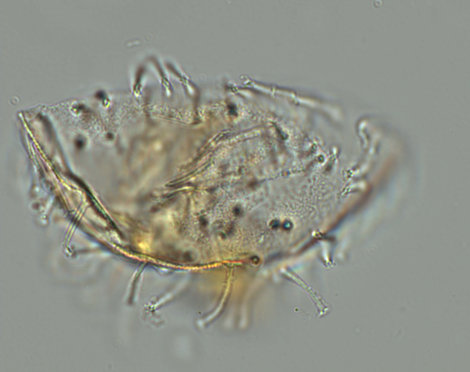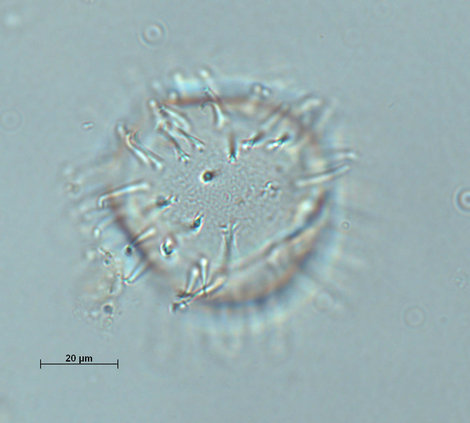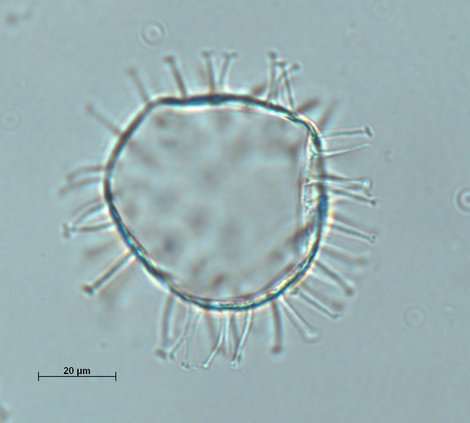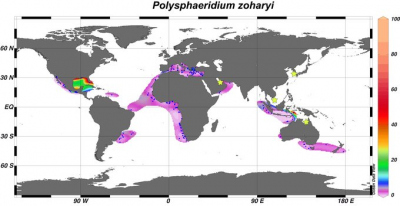Die Inhalte dieser Seite sind leider nicht auf Deutsch verfügbar.
Seitenpfad:
- Modern Dinocyst Key
- transparent cysts
- randomly distributed processes
- transparant cysts hollow processes
- Polysphaeridium zoharyi
Polysphaeridium zoharyi
Zonneveld, K.A.F. and Pospelova V. (2015). A determination key for modern dinoflagellate cysts. Palynology 39 (3), 387- 407.



lateral view
single grain - reference collection Bremen
photographs Karin Zonneveld
apical view
single grain - reference collection Bremen
antapical view
Field characteristics
Polysphaeridium zoharyi (Rossignol 1962) Bujak et al. 1980
Field characteristics:
Chorate spherical cyst, with smooth to microreticulate-microgranulate cyst wall. Processes are numerous (~ 60), hollow, open distally, with a variable length and a weakly striated base. Processes can be fused at their bases or can be distally bifurcate. Archeopyle is epicystal and often splits the cyst into two parts.
Dimensions: cyst body diameter: 43–55 µm; length of processes: 6–15 µm
Motile affinity: Pyrodinium bahamense Plate 1906.
Cyst-theca relationship: Wall and Dale, 1968
Stratigraphic range: Pleistocene to Recent.
Comparison with other species:
The distinguishing characteristic of this species is that it has an epicystal archeopyle. Furthermore, the processes are not evenly distributed over the cyst but often the bases of two or more processes are connected to each other. In contrast to Operculodinium centrocarpum the processes are often branched. The cysts are often folded.
Field characteristics:
Chorate spherical cyst, with smooth to microreticulate-microgranulate cyst wall. Processes are numerous (~ 60), hollow, open distally, with a variable length and a weakly striated base. Processes can be fused at their bases or can be distally bifurcate. Archeopyle is epicystal and often splits the cyst into two parts.
Dimensions: cyst body diameter: 43–55 µm; length of processes: 6–15 µm
Motile affinity: Pyrodinium bahamense Plate 1906.
Cyst-theca relationship: Wall and Dale, 1968
Stratigraphic range: Pleistocene to Recent.
Comparison with other species:
The distinguishing characteristic of this species is that it has an epicystal archeopyle. Furthermore, the processes are not evenly distributed over the cyst but often the bases of two or more processes are connected to each other. In contrast to Operculodinium centrocarpum the processes are often branched. The cysts are often folded.
Geographic distribution
Geographic distribution based on :
Zonneveld et al., 2013. Atlas of modern dinoflagellate cyst distribution based on 2405 datapoints. Review of Palaeobotany and Palynology, v. 191, 1-197
Zonneveld et al., 2013. Atlas of modern dinoflagellate cyst distribution based on 2405 datapoints. Review of Palaeobotany and Palynology, v. 191, 1-197
Polysphaeridium zoharyi is characteristic for coastal fully-marine subtropical to tropical regions which may have a high productivity. Although it is not restricted to areas with high upper water salinities it can form a major part of the association in regions where this condition occurs.

Distribution:
Polysphaeridium zoharyi is observed in coastal sub-tropical to equatorial regions. Abundances >50% (up to 98%) occur in the Gulf of Mexico and the Banda Sea (off Indonesia) where high upper water salinities and temperatures exist. It also is found in the South Atlantic and Pacific Oceans at large distances from the shore. With exception of the Mediterranean Sea it is not recorded north of 30°N and south of 40°S.
Environmental parameters:
SST: 8.9 - 29.8°C (winter - summer) with summer SST > 14°C. SSS: 28.4 - 39.4 (autumn - autumn), [P]: 0.06 - 1.1 μmol/l, [N]: 0.04 - 8.9 μmol/l, chlorophyll-a: 0.06 - 18.8 ml/l, bottom water [O2]: 0.05 - 6.0 ml/l.
Abundances >50% occur where upper temperatures are > 29.1°C in summer and >19.1°C in winter. High relative abundances are observed in regions with low phosphate and nitrate concentrations.
Phosphate concentrations in the upper waters are low to intermediate (0.06 - 1.1 μmol/l) and nitrate concentrations.
Comparison with other records:
Apart from the distribution recorded in this Atlas, Polysphaeridium zoharyi is registered from coastal sediments off southern Korea, the South China Sea, the Gulf off Oman, coastal areas off North Australia and off the NW Iberian peninsula (Marret and Zonneveld, 2003; Ribeiro and Amorim, 2008; Pospelova and Kim, 2010, Usup et al., 2012 and references therein). Sediment trap and seasonal distribution studies do not reveal a clear seasonal pattern in its cyst production (Ribeiro and Amorim, 2008; Zonneveld et al., 2010). In the past P. zoharyi has often been characterized as a species characteristic for elevated upper water salinities such as shallow lagoons (see discussion in Marret and Zonneveld, 2003). Although it is abundant to dominant in these environments, it is not restricted to them and in our dataset no positive correlation between salinity and its relative abundance can be observed.
Polysphaeridium zoharyi is observed in coastal sub-tropical to equatorial regions. Abundances >50% (up to 98%) occur in the Gulf of Mexico and the Banda Sea (off Indonesia) where high upper water salinities and temperatures exist. It also is found in the South Atlantic and Pacific Oceans at large distances from the shore. With exception of the Mediterranean Sea it is not recorded north of 30°N and south of 40°S.
Environmental parameters:
SST: 8.9 - 29.8°C (winter - summer) with summer SST > 14°C. SSS: 28.4 - 39.4 (autumn - autumn), [P]: 0.06 - 1.1 μmol/l, [N]: 0.04 - 8.9 μmol/l, chlorophyll-a: 0.06 - 18.8 ml/l, bottom water [O2]: 0.05 - 6.0 ml/l.
Abundances >50% occur where upper temperatures are > 29.1°C in summer and >19.1°C in winter. High relative abundances are observed in regions with low phosphate and nitrate concentrations.
Phosphate concentrations in the upper waters are low to intermediate (0.06 - 1.1 μmol/l) and nitrate concentrations.
Comparison with other records:
Apart from the distribution recorded in this Atlas, Polysphaeridium zoharyi is registered from coastal sediments off southern Korea, the South China Sea, the Gulf off Oman, coastal areas off North Australia and off the NW Iberian peninsula (Marret and Zonneveld, 2003; Ribeiro and Amorim, 2008; Pospelova and Kim, 2010, Usup et al., 2012 and references therein). Sediment trap and seasonal distribution studies do not reveal a clear seasonal pattern in its cyst production (Ribeiro and Amorim, 2008; Zonneveld et al., 2010). In the past P. zoharyi has often been characterized as a species characteristic for elevated upper water salinities such as shallow lagoons (see discussion in Marret and Zonneveld, 2003). Although it is abundant to dominant in these environments, it is not restricted to them and in our dataset no positive correlation between salinity and its relative abundance can be observed.


